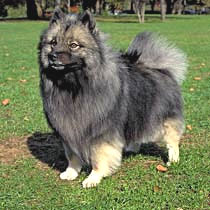|
The Canine Chronicles Directory
Keeshond

Keeshonds have an incredible weather resistant, double coat. The long outercoat
is coarse and the dense undercoat is downy. The hair on the outercoat stands away
from the body. The coat color is gray and tipped with black. The undercoat, feet
and tail are usually a cream color. Puppies are generally born solid black, turning
cream at four months and then the gray/black/cream mix by eighteen months. The wedge-shaped
head has a definite stop. His spectacled face gives him a curious, intelligent expression,
and his fox-like smile, complete with curled lips, shows his friendly attitude.
The triangular ears stand erect and the slanted eyes are chestnut in color. The
lips are black and the teeth meet in a scissor-like bite. They have round, compact
feet with arched toes. Their plumed tail is medium in length and curls over the
back.
|
|
Temperament
|
Keeshonds are friendly, lively, affectionate, alert, and generally outgoing. They
are great companions to children and need to be a part of family activities. They
should be socialized from an early age, but are usually good with other pets. They
are natural guard dogs and have an instinct for danger. They love to spin happy
circles and can be trained to perform.
|
|
Height, Weight
|
Male Height: 18-19" ; Weight: 35-40 lbs.
Female Height: 17-18" ; Weight: 35-40 lbs.
|
|
Health Problems
|
They are prone to hip dysplasia, heart disease and skin problems.
|
|
Living Conditions
|
Keeshond will do okay living in an apartment but do better with an average sized
yard. They prefer cooler climates and have a difficult time with heat because of
their thick coats.
|
|
Exercise
|
This breed has a great need for exercise. They need a good hour-long run each day,
preferably off their lead. You should not use a choke chain on this breed as it
interferes with its spectacular mane.
|
|
Life Expectancy
|
About 12-15 years
|
|
Grooming
|
This breed should be brushed or combed daily to keep the coat looking full and beautiful.
Brush with the grain and then, while lifting the coat, brush against the grain.
Bathe only when necessary. This breed is a heavy shedder twice a year.
|
|
Origin
|
The Keeshond was developed from arctic sleigh dogs, including the Samoyed, Chow
Chow, Elkhound, and Pomeranian. In the 18th century, at the beginning of the French
Revolution this breed became a symbol of a rebellion led by Kees de Gayselaer. He
rebelled against the Dutch House of Orange. When the monarchy returned to power,
this breed was almost completely eliminated. They were then used as guard dogs for
Dutch barges. The breed was first imported to Great Britain by Mrs. Wingfield-Digby
and to the United States during the 1920s by Baroness van Hardenbroeck. Keeshonds
were recognized by the AKC in 1930 and by the UKC in 1936.
|
|
Group
|
AKC Non-Sporting, UKC Northern Breed
|